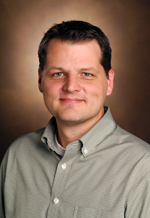
by Jane Sevier
Entering adult life can seem daunting for any high school student. Still, most graduates can expect further education, satisfying careers, networks of friends, comfortable homes and sufficient leisure time.
But for some young people with developmental, intellectual and physical disabilities, that dream may seem out of reach. For them, life after school often means little or no work, disengagement and poverty. To ease their passage to adult life, Vanderbilt University Professor Erik Carter and Professor Emerita Carolyn Hughes have developed a transition model that combines skill development with support, including strategies they outline in The New Transition Handbook (Brookes Publishing, 2012).

“Youth with disabilities have the same aspirations for adulthood as anyone else,” said Carter, associate professor of special education at Vanderbilt Peabody College of education and human development and an investigator at the Vanderbilt Kennedy Center for Research on Human Development. “[rquote]When equipped with the right skills, supports and services—they can flourish during life after high school.”[/rquote]
What can teachers, family members, friends and employers do to prepare students for success in the adult world? Identifying students’ strengths and preferences is crucial to developing their skills. Cultivating support at school, on the job and in the community while increasing students’ social competence also is vital.

Carter and Hughes describe inclusive methods that treat people with disabilities as competent and increase their independence and self-determination in tandem with social support and acceptance among the general population. Students learn to make their own choices, set goals, speak up for themselves and carry out their own plans, a shift from now-disfavored programs that isolated adolescents and young adults with disabilities.
For example, peoples’ abilities vary according to the demands and opportunities of particular environments. By observing their involvement in a variety of school, work and community activities and recording and evaluating these observations systematically—perhaps by devising checklists of study skills or social behaviors—teachers can pinpoint students’ strengths and needs. They can then use that data in developing educational programs tailored to those students. Teachers also can share the information gleaned with parents, fellow teachers, other students and employers.
Carter and Hughes argue that teaching students to take greater responsibility for their own behavior will help them use their skills when teachers or other service providers are not there to provide support. For instance, to help students learn to set goals, teachers might have them arrange their personal daily schedules and manage their own time. They also might make lists of the steps needed to achieve a goal, such as passing a driver’s test.
Educators and others involved in guiding students with disabilities into adult life will benefit from the strategies, forms and how-to guidelines on self-determination training, social skills instruction, access to the general curriculum and career development included in The New Transition Handbook.
In 2012, Carter received the Patricia L. Sitlington Research in Transition Award from the Council for Exceptional Children and the Young Professional Award from the Association of University Centers on Disabilities. He currently leads three federally funded projects focused on transition-age youth with disabilities. Hughes received the 2012 Education Award from the American Association on Intellectual and Developmental Disabilities, which is given for significant contributions in the field of intellectual and developmental disabilities.
The New Transition Handbook is available in bookstores and online. More details at Brookes Publishing Co.